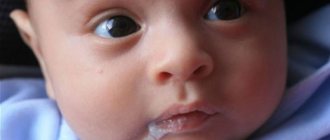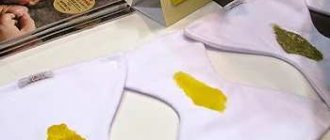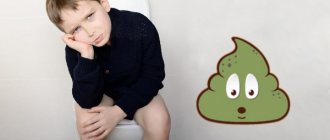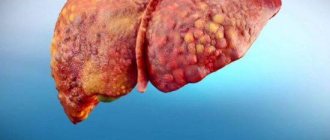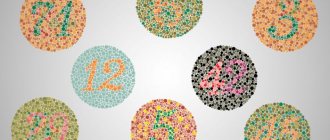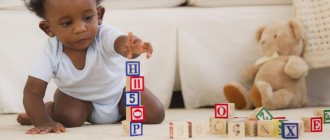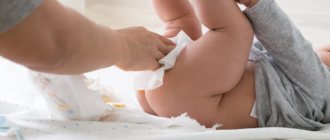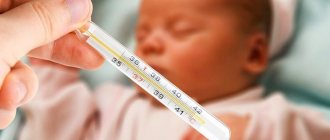Causes
Yellow stool indicates an upset stomach. The causes of its appearance are divided into infectious and non-infectious.
- rotavirus;
- harmful bacteria;
- inflammation of the mucous membranes in the intestines.
- lactose intolerance;
- poisoning;
- taking medications, such as antibiotics;
- stress;
- intestinal inflammation;
- non-invasive infections.
In infants, changes in stool are often associated with the mother's diet. The cause of diarrhea if the baby is bottle-fed is an incorrectly prepared formula.
When the stool changes, accompanying symptoms appear that will help determine the exact cause of the yellow stool.
Cause of yellowness
Why is normal newborn stool colored yellow? This color of stool is formed due to bilirubin, a yellow-brown blood pigment formed as a result of the breakdown of hemoglobin.
This substance is excreted from the body along with feces as part of bile. During normal functioning of the gastrointestinal tract, bilirubin is present in feces in a certain range, which determines their color.
The rich yellow color and creamy consistency of the discharge indicate that the baby is receiving a sufficient amount of mature milk and is absorbing it well. But foamy and very liquid stool that is green or gray in color with a distinct sour odor is a clear sign of trouble.
Symptoms
Diarrhea in children appears suddenly and is accompanied by visible symptoms. Diarrhea begins with seething in the stomach, pain, and the urge to go to the toilet becomes more frequent.
Associated symptoms:
- lack of appetite;
- the skin becomes pale;
- worsening mood, drowsiness;
- frequent loose stools;
- nausea;
- temperature increase.
Young children become capricious. The appearance of symptoms requires parents to provide first aid, and it is also necessary to call an ambulance.
Treatment
Prolonged diarrhea poses a great danger to infants, as it quickly leads to dehydration. To avoid such problems, it is first necessary to normalize the water-salt balance.
It is important for the baby to remain breastfed. He needs to be fed as often as required. Maintaining long intervals between feedings is strictly prohibited. If your baby is formula-fed, you can slightly reduce the serving size. However, you should give milk to your baby a little more often.
If constant regurgitation occurs, self-medication is strictly prohibited. In such a situation, the child must be urgently taken to the hospital.
To cope with the symptoms of dehydration, you need to give your baby plenty of fluids in addition to breast milk. It is best to use special saline solutions. These include Oralit, Regidron. You can also give your child clean water or tea.
If your child is drinking fluids normally between meals, he can be given a bottle or cup. If problems occur, give 1 small spoon every 5 minutes.
If the baby does not agree to drink water, he should be taken to the hospital immediately. The onset of dehydration is indicated by increased drowsiness, general weakness, lack of urination, dry palms, feet and lips.
If diarrhea with mucus appears, the doctor may prescribe Enterofuril, Furazolidone, Stop-Diar in the form of a suspension. The medicine must be taken in accordance with the instructions, strictly observing the dosage. If diarrhea is caused by infection with staphylococci or Klebsiella, it may be necessary to use bacteriophages.
In addition to the main therapy, the child is prescribed a special diet. Infants should continue to be fed with mother's milk - this will significantly speed up the recovery process. In this case, you should exclude juices and vegetable complementary foods. The baby can be fed meat and cereals.
The appearance of diarrhea and mucous impurities in the stool may indicate a variety of disorders. In most cases, this is not a symptom of a serious illness and indicates a violation in the diet of the nursing mother. If the child’s condition does not improve, you should immediately contact your pediatrician.
Fecal masses with a small mucus content are not a pathology. However, what should a mother do if she constantly finds large clumps of mucus on her baby’s diaper? Excessive impurities along with loose stools may indicate the presence of a dangerous disease. Intestinal infections, gastrointestinal diseases, metabolic disorders can cause diarrhea with mucous clots.
Foamy yellow stool
Foamy stools indicate intoxication of the body caused by fatty, spicy foods. Diarrhea for less than 3 days is not dangerous and goes away on its own if you follow a diet.
Causes:
- dysbacteriosis;
- viral infection;
- helminthiasis;
- inflammation of the stomach;
- eating fatty, spicy foods.
In a newborn, diarrhea with foam appears due to failure to absorb breast milk or formula. During the complementary feeding period, a new product can cause changes in stool. Seeing a doctor requires the presence of pus and bloody spots in the stool.
Possible complications
Diarrhea can cause a number of complications, sometimes not directly related to bowel function, but they occur due to lack of treatment. Complications can be expressed as follows:
- Dehydration.
- Inflammation of the middle ear.
- Pneumonia.
A competent examination by a specialist will help to avoid possible complications, which involves not only identifying the clinical picture visually, but also with the help of laboratory tests: urine, feces and blood tests. At an appointment with a pediatrician, the child’s heart rhythm should be checked, the whole body should be examined, and the baby’s reaction to tapping should be assessed.
The main factor that determines the outcome and speed of treatment is timely consultation with a doctor.
Diarrhea with mucus in infants is a fairly common condition that can be caused by various factors. The cause of the problems is the use of medications or disturbances in the diet of the nursing mother. However, sometimes such symptoms are associated with serious pathologies.
Temperature with loose stools
An increase in body temperature above 38 degrees Celsius with diarrhea indicates the presence of an infection in the baby’s body.
Causes:
- Rotavirus, which is accompanied by yellow stools and vomiting.
- Teething.
- Intestinal infections.
High temperature is accompanied by loss of strength and lack of appetite . If the use of antipyretics does not give the desired effect, it is recommended to consult a doctor to avoid dehydration.
The effect of rotavirus on children's stool
Children aged 6 months to 2 years are often susceptible to the infectious disease rotavirus. This intestinal disease is in many ways similar to a number of other ailments, but one of its main signs is its rapid development.
The first stage of the disease is accompanied by high fever. Following this, nausea develops, after which the child vomits and a state of general malaise sets in. The baby has frequent yellow stools with a liquid consistency. This means that the child’s body quickly becomes dehydrated. For a one-year-old baby, such alarming symptoms pose a direct threat to health and life, so if a characteristic clinical picture is present, it is worth seeking medical help.
Parents are also required to provide first aid to their child. Along with replenishing fluid in the body and controlling body temperature, it is necessary to ensure that the feces acquire a thick consistency. Liquid bowel movements can be slowed down with the help of sorbent preparations designed for use at the appropriate age. These medications help remove toxic substances from the body. Then the doctor prescribes medications to stabilize the stool.
Nausea and vomiting
Light yellow diarrhea and vomiting in a child may be due to exposure to an infectious disease, a cold. Symptoms affect the intestinal mucosa and lead to water imbalance.
What to pay attention to:
- weight loss;
- blood streaks in stool;
- rare urge to go to the toilet;
- dark yellow urine.
All signs indicate dehydration if they do not stop for more than a day. If signs of infection appear in a child under one year old, it is recommended to call an ambulance.
What are the dangers of chronic or acute diarrhea?
Diarrhea is a dangerous phenomenon for the baby’s body. In acute and chronic diarrhea, the following consequences may occur:
- intoxication;
- dehydration;
- violation of water-salt balance in the body;
- convulsions;
- cachexia (exhaustion);
- disruption of the cardiovascular system;
- muscle pain;
- development of dysbacteriosis;
- dysfunction of the neuroendocrine system;
- hypovitaminosis;
- rectal prolapse;
- decreased immune resistance of the body;
- cracks in the rectum.
Features of the intestinal structure
Dehydration due to diarrhea
Dehydration is an extremely dangerous condition for a baby. To eliminate the effects of dehydration, doctors prescribe a number of medications:
The dosage of solutions is calculated based on 100 ml per 1 kg of child’s body weight. You need to drink after each act of loose bowel movement or vomiting. Doctors do not recommend using Regidron for children under one year of age, since the concentration of active substances in it is high for infancy. If you have nothing on hand other than Regidron, before use you need to dilute it in double the volume of water.
Children over 6 months old can be given dried fruit compote. If necessary, the child should be fed by force, from a pipette or from a syringe without a needle. Dehydration may worsen, then its consequences will be eliminated in the hospital through glucose drips, which is much more painful for both the child and the parents.
Practitioners believe that children under one year of age do not have stable immunity, so the appearance of diarrhea is influenced by a variety of factors. The condition of feces is affected by any changes: bronchitis, otitis media, nervous shock, overheating, hypothermia. Before treating any disease, you need to understand why it arose, that is, determine its etiology. Only a qualified specialist can determine the exact cause of diarrhea. Without a diagnosis, it is impossible to cure a child.
Light yellow diarrhea in children under one year of age
A one-month-old baby's stool is bright yellow to light in color. This condition is not a pathology and no treatment is required.
Changes in stool in children under one year old, the appearance of an unpleasant odor, inclusions of mucus, are the causes of intestinal dysfunction. When taking antibiotics, the microflora changes.
Causes:
- feeding schedule is disrupted;
- dysbacteriosis;
- lactose intolerance;
- failure to follow instructions for preparing formula;
- teething;
- diseases of the intestines, liver;
- infections.
With dysbacteriosis, the stool is quite liquid and foamy. Normally, this phenomenon occurs in the first 3 weeks of a baby’s life . At 7 months, the first complementary foods are started, which can also cause diarrhea and yellowish stools.
Breastfeeding requires a woman to follow nutritional rules to avoid diarrhea in her baby. It is recommended to exclude legumes, fatty foods, fried foods, and carbonated drinks.
When to see a doctor:
- The baby constantly cries and kicks his legs.
- The baby refuses to eat.
- Mucus and streaks of blood appear in the stool.
- Heat.
- Skin tone changes.
Prevention of diarrhea in infants includes the diet of the nursing mother and the rules for introducing complementary foods. All food products are thoroughly washed and, if possible, treated thermally.
Prevention
If yellow diarrhea occurs in a breastfed baby, the mother needs to adhere to a diet. Foods that cause digestive upset in the baby are excluded from the diet. There are simple ways to prevent diarrhea:
- Give children only bottled or boiled water;
- use safe food products taking into account expiration dates;
- mother needs to maintain body and hand hygiene before feeding;
- introduce complementary foods after consulting a pediatrician;
- regular hygiene procedures for caring for the baby, wet cleaning of his room, washing toys;
- compliance with the frequency of feedings and amount of food recommended by the doctor according to age.
If diarrhea does appear, do not delay a visit to the pediatrician. Self-medication delays proper treatment and leads to complications of the disease.
WHO (World Health Organization) recommends breastfeeding babies for at least 6 months after birth. Breastfed babies suffer from intestinal infections half as often as bottle-fed babies. Maintaining good hygiene reduces the risk of digestive disorders.
Treatment methods
Treatment of yellow diarrhea begins with determining the cause of its appearance. They use medications, folk remedies, and diet.
First aid for diarrhea:
- drink more clean water;
- monitor body temperature;
- eat in small portions;
- give sorbent.
You cannot force a child to eat if he has no appetite. If the temperature rises, you need to give your baby an antipyretic.
Medications
Diarrhea medications:
- Sorbents: Smecta, Activated carbon, Enterosgel. Aimed at removing toxins.
- Probiotics: Bifidumbacterin, Acipol, Bifiform, Enterol. Restore intestinal microflora.
- Antihistamines: Zodak, Cetrin. Used for food allergic reactions.
- Enzymes: Creon, Pancreatin. Improves liver function.
Medicines are used as prescribed by the attending physician.
Traditional medicine methods
Folk remedies for diarrhea:
- Rice water. Rice is boiled in water. The broth is filtered and given warm to children: up to one year - 1 tablespoon, after one year - 100 ml three times a day.
- Water-salt solution. For a glass of boiled water: 20 grams of sugar, 10 grams of salt. Give your child a tablespoon of tincture every 15 minutes. Allowed for newborns.
- Oak bark. Pour boiling water over a tablespoon of bark and leave for half an hour. The strained broth is used for enemas.
The use of folk remedies, as well as medications, requires consultation with a doctor.
Nutrition correction
Food for diarrhea should be light, not greasy. Chicken broth with breadcrumbs is considered the best. The dish does not irritate the intestines, but at the same time saturates the body.
What should parents do if their baby has diarrhea?
Every mother should clearly know what can cause diarrhea in her baby, and what needs to be done in this situation. After each bowel movement, the mother should wash the baby well. Doctors in this case do not recommend using wet wipes, as they can provoke the development of allergies in the baby. Drug therapy is prescribed to a child only after a diagnosis has been made by a doctor.
First aid for diarrhea in a child
If the child is diarrhea without vomiting, then the young mother should try to stop the diarrhea by putting the baby to the breast as often as possible. The fact is that in this way the baby will be able to get both drink and food. Pediatricians allow children to be given Smecta or Enterosgel for diarrhea. The mixture should be given in small portions every 15-20 minutes. You can also use chamomile infusion. It has an anti-inflammatory effect. In case of elevated temperature, before the doctor arrives, you can give an antipyretic drug (Panadol, Nurofen).
When to urgently take your child to the doctor
If a breastfed or bottle-fed baby has diarrhea for more than two days, you should consult a doctor. A pediatrician should be called in the following cases:
- the fontanelle has sunk;
- the child has diarrhea and vomiting;
- basal temperature – 38 °C;
- the baby looks lethargic, apathetic, refuses to eat;
- lips are dry, there are no tears when crying;
- There are streaks of blood and mucus in the stool.
What to give to a baby with diarrhea
If a child has diarrhea and vomiting, then most likely he will need drug treatment, but only a pediatrician should prescribe it. It is believed that the best remedies for diarrhea are the following drugs:
- Enterofuril. Can be given to babies from 1 month (contraindicated in premature babies). This is an excellent antimicrobial drug that quickly copes with diarrhea and other symptoms of intestinal infections.
- Loperamide. It stops diarrhea well, but this medicine can only be used by children from the age of two. Doctors do not recommend using this remedy for colitis and diarrhea with hyperthermia.
- Enterol. Prescribe to children from 1 year. An excellent antimicrobial agent that has an antitoxic effect on the body.
- Phthalazol. It can be given to babies from two months. Has a wide spectrum of action. Used for various intestinal infections, such as dysentery.
- Tannacomp. Can be given to newborns. It is an antidiarrheal agent that has an astringent effect. At the same time, it also has an antispasmodic effect.
- Sulgin. Designed for babies from 6 months. This drug copes well with diarrhea, as well as colitis and dysentery.
- Lactobacterin is a probiotic that can be used even by newborns. This medicine can improve intestinal activity, metabolic processes, and also restore immunity.
- Hilak Forte - the medicine copes well with diarrhea, and also regulates the intestinal microflora.
- Bifiform is an excellent source of B vitamins, as well as probiotic microorganisms.
What to do to prevent relapses
To prevent recurrence of diarrhea, it is recommended:
- observe the rules of personal hygiene;
- prepare the milk mixture according to the instructions;
- Feed children only fresh foods.
- monitor your water balance.
Preventive measures will help avoid relapses and reduce the load on the intestines.
Yellow diarrhea in children of any age causes concern for parents. If, in addition to diarrhea, the temperature rises, vomiting and lethargy appear, this indicates an infection and requires the help of a doctor. Sorbents, probiotics, and antihistamines are used for treatment.
Mom very quickly learns to recognize what exactly causes her baby to cry: whether it is hunger, a wet diaper, or an unpleasant sensation in the tummy. But if in the first two cases the problem is easy to solve, then, unfortunately, determining the root cause of abdominal discomfort is much more difficult.
Often, young mothers lose peace and sleep, blame themselves for the baby’s hypothermia, non-compliance with the diet and, as a result, spoiled milk, and also find thousands of other probable reasons. We warn parents against making premature conclusions and suggest that they look into this delicate issue.
Causes of diarrhea in a baby
Diarrhea in a newborn can occur for various reasons. This condition is not always associated with infection. Most often, diarrhea in infants is provoked by physiological changes in their body.
If the baby begins to defecate with watery stools without accompanying symptoms, then you need to think about the etiology of this condition. There are many reasons that cause diarrhea. The main ones will be presented below.
The child does not need to be overfed, as this can provoke the development of many undesirable phenomena.
Errors in nutrition
Infants may experience intolerance to certain foods or their components, resulting in intestinal disorders in the form of diarrhea. This intolerance concerns the nutrition of a nursing mother. Very often there is an intolerance to cow's milk proteins, as well as gluten, a protein that is part of cereals. Constant consumption of such products by the mother leads to prolonged diarrhea in the child, the results are weight loss, allergic manifestations, flatulence, abdominal pain and, accordingly, general anxiety.
For your information. This condition, as a rule, does not require any special therapy. When you exclude the product from the diet, all manifestations go away. But determining which particular product causes intestinal dysfunction is very difficult.
Frequently changing breasts during feeding leads to the fact that the baby sucks only the front milk, without reaching the hind milk. In the absence of hindmilk, foremilk cannot be digested normally, since hindmilk contains lactulose, a special enzyme for digesting milk sugar. As a result, foremilk passes through the gastrointestinal tract too quickly and is not digested properly, causing stools that are noticeably loose and greenish in color.
Infection
The etiology of diarrhea is often associated with an infectious component. In such cases, diarrhea usually begins abruptly, accompanied by pronounced abdominal pain, fever, and vomiting, usually multiple times. Green diarrhea may appear in a newborn with streaks of blood, as well as mucus and foam. In this case, it is better to hospitalize the child.
Infectious diseases of newborn children have a particularly severe course. Any delay or provision of assistance in an insufficiently professional manner is fraught with fatal consequences or, at the very least, ending up in intensive care. There are a lot of bacterial and viral infections that affect children's intestines. One of the most common is rotavirus infection.
It is very difficult to determine the mixed type of diarrhea
Dysbacteriosis due to antibiotic use
Often, after antibiotic therapy, the baby develops diarrhea. Antibacterial drugs do not have quantitative and qualitative selectivity of action. They destroy not only pathogenic, but also beneficial microorganisms. As a result, dysbiosis occurs. To restore normal intestinal function, doctors prescribe pro- and prebiotics: Bifidumbacterin, Linex, Acipol.
Acute surgical pathology
Frequent bowel movements may be a symptom of appendicitis. In children not only of the newborn period, inflammation of appendicitis is accompanied by symptoms from the gastrointestinal tract.
Signs of diarrhea in an infant
How can you tell if your child’s digestion is normal or if it needs adjustment? How many times a day should babies have bowel movements and what consistency of stool is acceptable? Let's figure it out.
The following factors may indicate bowel dysfunction in a child of the first year of life:
- watery stool with greens . Liquid gray-green feces, often mixed with mucus, are typical for children in the first week and a half of life and should not cause concern to parents. The baby’s body is in a transition period when the intestines adapt to dairy foods and acquire their own microflora. You should not expect any hardness from your stool for at least the next three months. Breast milk has a laxative effect, causing soft stools with a consistency similar to fermented baked milk or thin porridge. The normal color of stool in the first months of life is considered yellow or mustard. The presence of the smell of milk protein is noticeable. Thus, loose stools in themselves are not a symptom of diarrhea, but should alert you in combination with the strong smell of feces, bloating and cramps in the tummy;
- frequent and abundant stools . Stool frequency is also a very conditional sign. The average norm at this time is considered to be “long hikes” from four to eight times a day. However, a baby can soil diapers literally after every “snack”, that is, up to 12 times daily. At the same time, even eight excessively loose bowel movements may indicate problems if, for example, before this the baby pooped four or less times a day, while having a good appetite and healthy sleep;
- weakness, anxiety, crying . The slightest change in the child’s mood and behavior will not hide from the mother’s sensitive attention. If an active and smiling baby has become lethargic, refuses usual games and sleeps more than usual, this is a reason to be wary. Physical weakness accompanied by frequent urge to go to the toilet may indicate a lack of beneficial bacteria in the microflora, which help digest food and absorb nutrients. Indigestion is a rather painful phenomenon even for adults. And for kids this is a complete test. Painful sensations in the abdomen can cause moodiness, prolonged crying, and night awakenings. Even in the absence of other symptoms, if this continues for more than one day, you need to consult a doctor;
- the appearance of blood, mucus or foam in the stool . Bloody, foamy impurities and mucus in the stool can seriously alarm mothers. In this case, foam in loose stools may occur due to improper attachment to the breast, which is not so difficult to eliminate. Foaming is possible if the baby receives only foremilk, that is, he is not allowed to the “source of nutrition” for long enough, or the mother alternates breasts too often. When feeding is established, bubbles and foam in the stool are no longer detected. Mucus in moderate doses should also not cause parental concern. It's another matter if there are orange or green flakes in the mucus. This is how salmonellosis or coli infection often manifests itself - E. coli. Diarrhea with bright scarlet blood splashes is dangerous. It may indicate intestinal colitis, which causes inflammatory-dystrophic changes in the intestines, or dysentery, an acute intestinal infection;
- temperature increase . A high temperature in combination with loose stools can be a symptom of diarrhea of a non-infectious nature: this is how the body reacts, for example, to teething, which will also be indicated by swollen gums and profuse salivation. In this case, you just need to help the baby get distracted and endure two to three painful days, after which the first teeth will appear. But infectious diarrhea requires immediate medical attention.
As you can see, symptoms of diarrhea in infants are sometimes a variant of the norm, but they can also indicate health-hazardous conditions. When you can cope on your own, and when you definitely need to see a doctor, how to treat diarrhea in a child depends on the root cause of the bowel disorder.
Why does a child have diarrhea: possible reasons
Diarrhea in infants can be caused by various reasons. Diarrhea can be a symptom of influenza or tonsillitis - a serious test for the infant’s fragile immunity. An acute respiratory infection can be suspected if there is a cough, nasal congestion, redness and swelling of the nasopharynx. The best decision is to call a pediatrician at home. If parents also notice a rash, they should call a doctor immediately: the baby may have contracted scarlet fever, measles or rubella.
Diarrhea may also indicate an intestinal infection or food poisoning: for example, if the child has eaten expired or allergic foods. A newborn's stool disorder can also be provoked by the nursing mother's consumption of "undesirable" foods, such as mushrooms, sausage, soda, and citrus fruits.
Diarrhea coupled with an increase in temperature is detected with serious surgical problems: peritonitis, appendicitis, volvulus. Often, pathologies of the gastrointestinal tract are also accompanied by vomiting.
One of the most common causes of loose stools in a baby is dysbiosis - a violation of the quantity and composition of beneficial intestinal microflora. Nine out of ten babies under the age of one year experience this phenomenon; WHO does not even classify it as a disease. Diarrhea due to dysbiosis occurs more often and longer in weakened, premature babies.
The causes of dysbiosis and, as a consequence, diarrhea in infants may be as follows:
- late breastfeeding . Even a half-hour delay between birth and the first feeding can have a detrimental effect on the baby’s health. Colostrum is rich in components that stimulate the development and growth of bifidobacteria, and their deficiency can result in diarrhea in the newborn. For the mother, the consequences are also unpleasant: this is fraught with a decrease or even disappearance of milk, a longer and more painful period of postpartum rehabilitation;
- artificial feeding . High-quality and carefully selected infant formula is a worthy alternative to breast milk, but it cannot fully replace it. Together with mother's milk, the baby receives immune protection, which helps its intestines suppress the growth of pathogenic bacteria and increase the number of beneficial microorganisms;
- poor or unhealthy diet . A balanced diet and a regulated diet are the basis for proper physical development, good health and mood of the baby;
- lactose intolerance . The child’s body’s rejection of milk protein, one of the fundamentals of nutrition for babies under one year of age, is a big problem. By digesting lactose, the body receives the “building blocks” necessary for cell growth and development. And loose stools are an even lesser evil caused by lactose intolerance;
- diseases that cause malabsorption in the intestine . Maldigestion syndrome (improper digestion) can be caused by various reasons. The most obvious are inflammatory or chronic diseases of the gastrointestinal tract: stomach, pancreas, small intestine. These include: gastroduodenitis, peptic ulcer, nonspecific ulcerative colitis. But malabsorption of nutrients can also be caused by malfunctions of other organs and systems, such as the liver or cardiovascular system. Only medical diagnostics and test results can indicate the root cause of health problems;
- allergic diseases . Food allergies and atopic dermatitis also often lead to consequences in the form of loose stools. Unfortunately, allergies are the scourge of the modern world, and it is rare that a person has not encountered manifestations of this autoimmune disease. Diarrhea is one of the small body’s attempts to resist allergens and physically get rid of them. Unfortunately, this does not always turn out to be an effective measure in the fight against the disease - rather, on the contrary. Due to insufficient supply of nutrients, the body quickly depletes energy reserves and weakens. If you suspect an allergy, you should contact your pediatrician as soon as possible and consult with an allergist;
- acute infectious diseases . A child may also react to intestinal infections, flu and other gastrointestinal diseases with loose stools. This is a self-cleaning mechanism, the release of pathogenic microbes from the body. However, the efforts of a fragile infant body, as a rule, are not enough; medical assistance is needed;
- Long-term use of antibiotics and other medications weakens the immune system and destroys healthy microflora involved in the breakdown and absorption of food. Antibiotics are equally merciless against both pathogenic and beneficial bacteria. After completing the course of treatment, the number of “correct” microorganisms must be urgently restored.
Loose stools or diarrhea - what's the difference?
A newborn has yellow diarrhea, a paste-like consistency with a pronounced sour-milk odor - the norm for a breastfed baby. Infants up to 2 months empty their intestines after each feeding, approximately 5-7 times a day, artificial ones somewhat less often. By the end of the third month, the stool becomes denser, turns brown, and bowel movements occur 2-3 times a day.
A change in the color and consistency of stool is observed with the introduction of complementary foods, which is associated with a reaction to new food. The stool is fully formed by 8-9 months.
- the feces have become very liquid, foamy, and there is a general deterioration in the child’s condition;
- bowel movements occur much more often, sometimes defecation occurs through a sudden release;
- feces have a strong unpleasant odor, become green, swampy, dark in color, which indicates infection with pathogenic bacteria; with dysentery, the feces are bright and multi-colored;
- feces contain impurities of mucus, blood, pus, a lot of undigested milk or food;
- the skin around the anus turns red;
- the temperature rises or falls, nausea, vomiting, signs of dehydration and intoxication appear, the baby burps more often than usual;
- weight loss is observed;
- the skin becomes pale.
Sometimes diarrhea goes away on its own within 1-2 days; severe forms of the disease require specialist intervention.
Causes of diarrhea in a child
Diarrhea in a child can be caused by various reasons; they do not always pose a serious threat to the baby. Hypothermia, overheating, and fatigue can trigger diarrhea.
Why does diarrhea occur in newborns?
In breastfed children, diarrhea is often caused by the mother's poor diet. If you eat a lot of fresh vegetables and fruits, fatty meats, and herbs during lactation, then you cannot avoid digestive problems in your baby.
- Products that cause allergies.
Food allergies often occur due to a lack of enzymes. It is necessary to monitor which foods cause diarrhea and exclude them from the child’s diet.
- The child's body does not absorb food components.
Poor digestibility of lactose, gluten, cystic fibrosis - with such pathologies, the child does not gain weight well, and a rash often appears on the skin.
Fever, diarrhea, increased moodiness, refusal to eat, excessive salivation - if these symptoms appear in a baby older than 6 months, carefully examine the gums; their redness and swelling indicate the imminent appearance of a baby tooth.
- Intestinal infections.
Vomiting, fever, frequent diarrhea. If the cause of diarrhea is salmonella, dysentery bacillus, or amoebas, then due to severe dehydration and heat, convulsions may begin, and the fontanelle may sink.
Disturbances in the balance of intestinal microflora often occur in infants under six months of age. In older children, a similar problem may arise after antibiotic therapy.
Diarrhea is accompanied by abdominal pain, allergic reactions, and signs of a cold.
Diarrhea often occurs in children due to colds and flu.
Diarrhea, acute pain, bloated abdomen, increased gas formation, bloating, a sharp increase in temperature, severe vomiting - these signs also indicate inflammation of the appendix, peritonitis, and intestinal obstruction. All pathologies require immediate surgical intervention.
Normal stool in a baby
Diarrhea is an increase in the frequency of bowel movements. The intestinal motor function of a one-month-old baby is quite energetic, which is manifested by frequent bowel movements: in the first two weeks in a newborn - 3-5 times, during the first year of life - 1-3 times a day, in a one-year-old child - 1-2 times a day. In infants, the process of defecation is a spontaneous (reflex) act, and starting from two years of age, bowel movements are a voluntary (conscious) process.
The child's first bowel movement occurs during the first day of life and is called meconium (original feces). It consists of epithelial cells, bile, enzymes and has a greenish-black color. The manifestation of meconium is necessarily recorded in the developmental history of the newborn, as this indicates intestinal patency. The stool of a breastfed baby is yellow in color and has the consistency of liquid sour cream with a sour odor.
Since artificial formulas for feeding are absorbed in the gastrointestinal tract longer than breast milk, the baby can defecate 2 times less often. At the same time, the volume of feces will be greater. The stool of a formula-fed baby is light yellow in color with an unpleasant odor. If the feeding formula is poorly absorbed in the digestive tract, white lumps may appear in the stool.
A child's normal stool ranges in color from bright yellow to light yellow. The color of stool begins to change and becomes brown only after the introduction of complementary foods at 6 months. In the first year of a child’s life, loose, yellow stools are not a pathology and do not require treatment.
Causes of pathologies
There are several diseases that are accompanied by diarrhea in infants:
- Functional disorders have terrible consequences. They are treated on an outpatient basis under the supervision of a pediatrician. Pathologies of this type can lead to dehydration. The reason for their appearance is a violation of the diet by the nursing mother (unbalanced nutrition), non-compliance with the rules for introducing complementary foods, and teething. Intestinal disorders can be combined with decreased appetite, flatulence, and the presence of undigested pieces of food in the stool. Antifoam agents, probiotics and preparations with simethicone are used for treatment.
- Watery stool in a newborn occurs with dysbacteriosis of various natures. With it, there is a decrease in the number of lacto- and bifidobacteria, which are necessary for the baby to absorb the breakdown products of fats and carbohydrates. Without them, normal digestion of food is impossible. In place of dead beneficial bacteria, pathogenic microorganisms enter the intestines. This type of pathology is characterized by diarrhea and chronic constipation. For treatment, drugs with cultures of living bacteria are used - prebiotics, eubiotics.
- Against the background of diseases of the respiratory system of the body, extraintestinal disorders appear. What complicates the child’s condition is that such diseases are often treated with antibiotics that kill beneficial intestinal microflora. Treatment is carried out with prebiotics and probiotics.
Pediatricians often recommend preventing the occurrence of extraintestinal disorders. To do this, prebiotics and fermented milk products enriched with them must be taken simultaneously with antibiotics.
- Malabsorption is much less common than other pathologies. It is also accompanied by loose stools in infants. With it, the amount of digestive enzymes produced is extremely small or completely absent. There are two types of pathology: lactose intolerance and celiac disease. If there is lactose deficiency, the child must be fed dairy-free formulas; in the second case, the diet is adjusted (usually grains are excluded from it).
Most often, loose stools in infants are not a cause for concern. This symptom does not require specific treatment or strong medications. The easiest way to get rid of diarrhea is by adjusting the mother's diet and taking special products enriched with beneficial bacteria. Treatment should not be stopped after improvements appear, otherwise a relapse is possible.
Mothers carefully study their babies almost from the moment of the first cry. Everything is noted: whether the eyes are funny, whether the nose is warm, whether the cheeks are plump, whether there are constrictions on the arms and legs. With no less curiosity and amazing pedantry, young mothers study the contents of a diaper or diaper for several minutes, looking at the quantity, color, and character of the stool. Even the smell of feces is given more than enough attention. And this is an absolutely correct approach to the issue of child health.
It is precisely such observations of the baby’s bowel movements that will help the mother determine the health status of the baby, the degree of absorption of mother’s milk and whether the nurse eats correctly. So what does normal stool look like for a naturally breastfed baby? What consistency, color and smell are normal, and when is it time to go to the neonatologists? This is what we will find out now!
Causes of diarrhea
Why does a child have yellow diarrhea? In a young child, loose yellow stools can occur for a number of reasons:
- violation of feeding regime,
- improper introduction of complementary foods,
- changing the diet of a nursing mother,
- intestinal infections,
- diseases of the stomach, pancreas, liver,
- overfeeding the baby,
- intestinal dysbiosis,
- lactase deficiency,
- teething.
In an infant, diarrhea after antibiotics may occur due to the suppression of normal intestinal microflora by antibacterial drugs. In this case, it is necessary to undergo a stool culture for dysbacteriosis, a stool analysis for opportunistic microflora and coprogram. Based on the test results, the doctor will be able to prescribe adequate treatment.
Loose stools in infants often occur during teething. At the same time, the baby begins to salivate profusely and the temperature may even rise slightly.
Frequent, liquid, yellow, foamy stools in a newborn may be a sign of physiological dysbiosis. It occurs during the first two weeks of a child’s life, as the intestines are actively populated by new microflora. At the beginning of the 3rd week in healthy full-term infants after feeding with mother's milk, this condition self-liquidates. Frequent loose stools with white lumps can also be a sign of dysbiosis.
Foamy diarrhea in a child without fever occurs with lactase deficiency, increased gas formation and allergies to foods that the nursing mother eats.
Dangerous diseases
In some cases, bright yellow stool in a child can be a sign of a dangerous disease.
You can suspect a pathological process in your child’s body by the presence of several unpleasant symptoms, which depend on the underlying disease. Children's feces change color due to hepatitis. The characteristic clinical picture of the disease is manifested by the addition of nausea, as a result of which appetite completely disappears. The child becomes lethargic and apathetic. Urine appears dark brown, after which the stool becomes lighter. At first, the feces take on a yellow-gray tint, but over time they turn white.
In children under one year of age, hepatitis B rarely appears. This type of hepatitis is characterized by a latent phase that lasts up to six months. First, the urine darkens, the feces become bright, and then lighten. The second stage of the disease is characterized by loss of appetite and sleep disturbance. This is followed by an increase in temperature and vomiting.
Pancreatitis is considered an equally dangerous disease. It also affects the child’s stool: when the baby is 1 year old or less, the stool is always lightened. At the same time, the baby complains of stomach pain and nausea. There is severe thirst, bloating and a rise in temperature. In children 2 years of age and older, pancreatitis often develops due to excessive consumption of sweets.
When to see a doctor?
In the first months of life, it is quite difficult for parents to determine whether a child has diarrhea, since bowel movements occur much more often than in adults.
Signs of "danger":
- the number of daily bowel movements exceeds the norm,
- accompanied by an increase in temperature,
- the child refuses to eat,
- diarrhea with foam in a child,
- yellow diarrhea with mucus,
- watery stool
- vomiting, nausea,
- the baby is constantly restless, cries, knocks his legs or is lethargic,
- signs of dehydration: the newborn’s fontanelle is sunken, mucous membranes are dry,
- there is mucus in the stool; after the introduction of complementary foods, there may be pieces of undigested food.
If at least one of the above symptoms appears, you should immediately consult a pediatrician to determine the causes of diarrhea in children.
In a newborn, loose stool “water” always leads to dehydration and is a very dangerous condition. What to do in this case? Treatment involves adequate replenishment of the body's water balance. Rehydration agents are administered intravenously or orally, depending on the degree of fluid loss.
Frequent loose stools with white lumps may indicate severe intestinal dysbiosis. This condition can also occur in children who are bottle-fed, since not all formulas are equally well digested in the child’s gastrointestinal tract.
How to give first aid
Many mothers begin to panic when they first encounter severe diarrhea in a child, but there is no time to waste time worrying - diarrhea in a baby quickly leads to dehydration, which is extremely dangerous for small children. Signs of dehydration are rapid weight loss, lack of urination for more than 4 hours, crying without tears, dry lips, and the child becomes lethargic.
How to help your baby
If diarrhea occurs in an acute form, any treatment can be started only after consulting a doctor.
Types of diarrhea
Foamy diarrhea in an infant, which has a strong odor and is accompanied by an increase in temperature, as well as symptoms of intoxication, indicates the presence of an intestinal infection. Classification of acute intestinal infections by type of diarrhea:
- Invasive type. Acute intestinal infections of bacterial etiology. They are caused by Salmonella, Shigella, some types of Escherichia, Yersinia and other pathogens. Pathogens can invade the epithelium of the gastrointestinal tract and cause foamy stool. Watery diarrhea with yellow-green mucus mixed with blood in a child often indicates salmonellosis. Green stool and small amounts (“rectal spitting”) indicate the occurrence of shigellosis.
- Secretory type. Such diarrhea in an infant can be of bacterial etiology (Vibrio cholerae, enterotoxigenic Escherichia, Klebsiella, Campylobacter, etc.) or viral (rotaviruses, coronaviruses). These pathogens multiply only on the surface of the intestinal epithelium. This type of diarrhea causes very loose stool in a newborn, looking like “water.” Yellow diarrhea in infants and older is a clear sign of rotavirus infection.
- Mixed type. Caused by a mixed infection, clinical signs include symptoms of both invasive and secretory types.
To isolate the suspected pathogen, feces, vomit, and gastric lavage are used, where it is identified using bacteriological examination. Its main disadvantage is the long time it takes (5-7 days); sometimes diarrhea in a newborn can be cured even before results are obtained. Serological tests are also used to detect the titer of antibodies to a specific pathogen.
Treatment of acute intestinal infections is prescribed by a doctor, since loose stools in an infant can quickly lead to dehydration with serious consequences. Rehydration and detoxification therapy are prescribed, and antibacterial drugs are prescribed for bacterial infections.
How to help a baby?
If liquid yellow stool occurs in a newborn, in order to normalize the stool and the baby’s well-being, doctors recommend:
- changing the mother’s diet, excluding from it fatty, fried, spicy and pickled foods, fresh fruits and vegetables;
- breast-feeding;
- refusal to give the baby additional water until the child reaches 6 months;
- changing baby formula if the baby is bottle-fed.
If the loose stool of a newborn during breastfeeding or bottle feeding is prolonged, looks like yellow water (a sign of rotavirus), or is caused by other pathological causes - bacteria, infections, viruses, treatment is necessary.
Symptomatic treatment of yellow diarrhea in a newborn baby involves the use of such medications.
- Rehydrants: electrolyte Humana, Gastrovit, Orasan, Maratonic, Gidrovit. Helps replenish lost fluid and normalize water-salt balance.
- Sorbents: Smecta, Atoxil, Polysorb, Enterosgel, Neosmectin, Lactofiltrum. Helps normalize stool and cleanse the body of harmful substances.
- Antipyretic drugs: Panadol, Efferalgan. Helps in reducing temperature.
Etiotropic treatment of loose stools in infants as yellow water is to use:
- Drugs with antibacterial properties: Nifuroxazide, Cefazolin, Cephabol, Rocephin, Ampicillin (for intestinal infections);
- Probiotics: Lactobacterin, Hilak Forte, Trilacta. Helps restore the balance of intestinal microflora.
Therapy for loose yellow stools, if it is caused by a malfunction of the gastrointestinal tract or a disease of an infectious nature, should be carried out at any age, both a 1-month-old child and a one-year-old child.
Prevention of yellow diarrhea
In a newborn, diarrhea is easier to prevent than to treat. To this end, you must adhere to the following rules:
- a nursing mother should be on a hypoallergenic diet,
- follow the rules for introducing complementary foods (at 6 months - vegetable puree, at 8-9 months - low-fat pureed
- meat, at 10-12 months. - steamed fish cutlets),
- keep baby care products clean,
- observe food expiration dates,
- carefully thermally process food products,
- Avoid feeding your baby cow's milk.
Liquid yellow stool in a newborn is normal. If diarrhea occurs or foamy, watery or greenish stool appears, you should contact your pediatrician.
Problems with stool and nutrition
Green, foamy and liquid stool with a sharp sour odor may be the result of errors in the diet of a baby or nursing mother. Namely:
- The baby drinks too much of the sugar-laden front milk and not enough of the nutritious rear treat. Signs of this problem are underweight and flatulence. You can solve this by expressing a little before feeding.
- Mom abuses foods that cause allergies or contain substances that irritate the intestinal mucosa. Among such foods are whole milk, chocolate, fast food, and treats with chemical additives. In addition to problems with stool, allergies are indicated by a rash on the baby’s body, itching and restless behavior. To eliminate unpleasant symptoms, mom needs to change her diet. You may need to take medications (sorbents and antihistamines), but only as prescribed by a doctor
Causes of appearance in children
Liquid stool with mucus in a child is a mandatory reason to contact a pediatrician. The organs of the digestive system in a one-year-old baby are not yet sufficiently developed. After 6 months, mothers begin to actively introduce new foods into their children’s diet. Together with them, he receives a huge number of microbes, which happily populate new spaces. Mucus in stool is a common occurrence among infants and young children.
Loose stool without high temperature with mucus is not an independent process; in most cases, the disorder is associated with dysfunction of the digestive system. Many diseases manifest themselves as unpleasant symptoms; they need to be thoroughly examined to identify the true cause of the pathological condition.
Infectious nature
An intestinal infection is a disease that occurs as a result of the growth and reproduction of pathogenic bacteria within the gastrointestinal tract. Children love to taste household items; sometimes such an experience ends in infection with rotavirus. Food products may contain harmful microorganisms.
If intestinal intoxication in an adult is sluggish, the child suffers from many symptoms of the disease. He develops nausea, vomiting, green diarrhea with the release of pathological impurities, lethargy, and severe weakness. High body temperature and dehydration finally exhaust the child’s body. The toxins released by the bacilli eventually enter the bloodstream and spread throughout the systems and organs. Additional symptoms are added. Untimely visits by young parents to the hospital end up in the intensive care unit.
Non-infectious
- In infants, the appearance of diarrhea is often associated with a violation of the diet. Breastfeeding women must follow a diet to ensure that the baby receives beneficial nutrients through breast milk. It is recommended to feed on demand.
- Enzymopathy is a pathological condition that occurs in the absence of enzymes that break down complex compounds. Lactase deficiency refers to the described condition. The child does not accept milk due to insufficient production of lactase (intestinal enzyme). Mothers note the appearance of liquid, foamy stool in the baby after feeding. The frequency of bowel movements increases to 8-10. The condition is treated by switching to special milk formulas. Another option is to continue breastfeeding and give a medicine called Lactase baby, Lactase enzyme. Lactase deficiency can occur when drinking cow's milk. Eliminate it from the children's diet and the problem will disappear forever.
- Improper introduction of complementary foods is a common cause of stool disorder with mucus discharge. Vegetable puree or gluten-free cereals (buckwheat, rice, corn) are recommended to be given to the baby from 6 months. Sometimes inexperienced mothers begin to introduce complementary foods early or, conversely, late. Then the little organism gets sick. If you have no motherhood experience, contact your local pediatrician to protect your baby from health problems.
- Dysbacteriosis is a pathological condition characterized by an increase in pathogenic microflora inside the intestine, a violation of the protective forces of the gastrointestinal tract. Many medications negatively affect the intestinal flora, which leads to the activation of harmful bacteria. Lacto- and bifidobacteria are responsible for local immunity and the functional activity of the large intestine. Popular antibiotics kill microorganisms without exception. To prevent the development of a pathogenic condition, it is necessary to play it safe with probiotics. They replenish intestinal flora and reduce the level of harmful bacteria.
- The period of teething is a difficult time for the baby. Constant anxiety and painful sensations prevent you from being fully satisfied during feeding, the baby puts his hands in his mouth. During this period, the immune system weakens and an intestinal infection may develop. The stool becomes green, foamy, and contains pathological impurities.
- Liquid stool with mucus appears in a child as a residual phenomenon after inflammatory bowel diseases.
- Crohn's disease and ulcerative colitis are rare pathologies with severe diarrhea syndrome.
Causes of mucous diarrhea
Before doing anything to stop diarrhea, parents and a doctor should determine the cause of the disorder. Liquefied mucous feces are symptoms of infectious diseases. In acute and chronic forms, diarrhea can be released not only with mucus, but also with fatty inclusions and blood.
If the stool flows in a stream with a predominance of mucus, the condition indicates an acute intestinal infection. Slippery lumps form as the intestines fight disease, when the tract removes water and salts from its thin section. Children often suffer from infectious diarrhea in the summer; viral diarrhea usually occurs in the winter.
The main causative agents of diarrhea with mucus in a child are:
- Giardia;
- salmonella;
- cryptosporidium;
- rota and enteroviruses;
- enteropathogenic and enterotoxigenic coli.
If diarrhea with mucus is not infectious in nature, it may be a consequence of gastroenteritis or enterocolitis. Other causes of loose, mucous stools are lactase deficiency, individual intolerance to cow's milk, and overeating.
Among the factors that provoke a change in the nature of bowel movements is an incorrect or unbalanced diet. In addition to complaints about frequent urges, children may talk about nausea, general malaise, and rumbling in the stomach. Sometimes these signs indicate irritable bowel syndrome. IBS is confirmed by bacteriological examination of stool.
